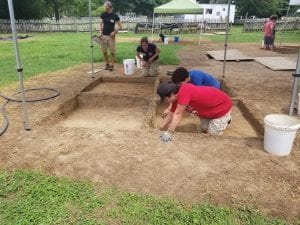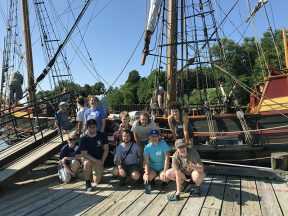By Mace Long
During the summer, I spent ten weeks concentrating on gaining skills in excavation,  data collection and archeological recording in the field, laboratory and classroom at the St Mary’s College of Maryland Historical Archeological Field School. At the late 17th century Leonard Calvert House, I personally unearthed part of a horseshoe, a lock mechanism, Rhenish stoneware, Venetian glass, creamware, projectile points, fragments of oyster shells, iron nails, pieces of clay tobacco pipes and much more. Chief Archaeologist Travis Parno emphasized that “these excavations at the site of Maryland’s first capital have revolutionized the understanding of colonial architecture and the material culture of the period.”
data collection and archeological recording in the field, laboratory and classroom at the St Mary’s College of Maryland Historical Archeological Field School. At the late 17th century Leonard Calvert House, I personally unearthed part of a horseshoe, a lock mechanism, Rhenish stoneware, Venetian glass, creamware, projectile points, fragments of oyster shells, iron nails, pieces of clay tobacco pipes and much more. Chief Archaeologist Travis Parno emphasized that “these excavations at the site of Maryland’s first capital have revolutionized the understanding of colonial architecture and the material culture of the period.”
The archeological field school site is part of Historic St Mary’s City surrounded by a large living history area, museum and The Maryland Dove ship. While spending full days excavating at the site, we took turns giving public tours. It was fulfilling to be able to discuss the background history and present the successes of our dig site.
During the Tidewater Archaeology Weekend, I witnessed the incredible instructive value of allowing people of all ages to sift through dirt themselves and be educated physically with exciting hands-on participation. In addition, I greatly enjoyed the variety of field trips to Colonial Williamsburg, Jamestown and Montpelier where we observed methods used by other sites.

As part of the St Mary’s College of Maryland’s Historical Archaeological field school, we boarded and rode the Maryland Dove learning all kinds of techniques and mechanisms regarding 17th century ships. (IUP Graduate Student Mace Long)
The St Mary’s College of Maryland Historical Archaeological Field School was one of the most incredible educational experiences of my life, as it heightened my understanding of A.L. Kroeber’s quote “[Archaeology] is the most humanistic of the sciences and the most scientific of the humanities.”
Photos provided by Mace Long and the Historic Saint Mary’s City Field School Blog

